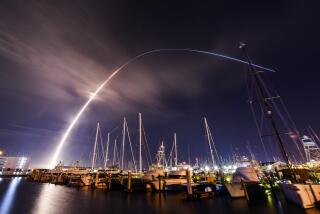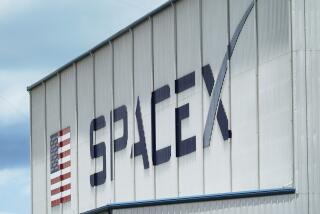SpaceX to launch Crew Dragon capsule without humans aboard
Until 2011, NASA relied on a single, versatile design to both ferry astronauts to space and transport enormous scientific instruments. It was known as the space shuttle, but in operation, it was more like a space pickup truck.
Late Friday night, Pacific time, a new generation of astronaut transporters will lift off with a far more specialized purpose.
When SpaceX launches its Crew Dragon capsule — without humans — for its first test mission, it will signify a major shift in the way NASA does business. The launch again sets NASA on a path toward craft designed not to be a jack of all trades but a master of one. And it marks the beginning of new partnerships with commercial firms that will design, build and own the vessels that take the agency’s astronauts to space.
“We are now able to take advantage of commercial industry in a way that used to not even be available to us,” NASA Administrator Jim Bridenstine said during an interview in mid-February. “Where risk has been retired and markets develop, we want to be a customer. Then we can use our money to do what we’re intended to do, which is explore and make discoveries and do science.”
Since its start, NASA’s human spaceflight programs revolved around craft owned by the agency. Though contractors built the Apollo capsule and the space shuttles, NASA oversaw every aspect of development and the vehicles were tested, launched and operated under the agency’s oversight.
When the decades-old shuttle program ended amid rising costs and growing safety concerns, NASA started relying on commercial companies to take supplies to the space station. In 2008, the agency first awarded $1.6 billion to Hawthorne-based SpaceX for 12 resupply flights and $1.9 billion for eight flights to Orbital ATK, which was acquired by Northrop Grumman Corp. last year. Additional awards followed.
A NASA audit released in April on the uncrewed commercial resupply services program found that “continued reliance on commercial operators to provide this vital service could play a major role in NASA’s future plans as it searches for cheaper and more efficient methods to explore space.”
NASA’s embrace of commercial firms for closer-to-home missions is indicative of what’s happened in other industries, analysts said. Just look at the internet, which was originally developed by a U.S. military technology development agency, but became fertile ground for commercial companies, said Phil Larson, a former senior advisor for space and innovation in the Obama administration who previously worked at SpaceX.
“Once the government has done it, then it makes sense to push it over into the marketplace,” said Carissa Christensen, chief executive of analytics and consulting firm Bryce Space and Technology. “That happens all the time for all kinds of technologies This is just a very dramatic one.”
In 2014, SpaceX and Boeing won NASA contracts worth a combined total of $6.8 billion to develop crew capsules.
Under what’s called the Commercial Crew program, NASA released a “broad set of requirements” needed to ensure crew safety, the agency said. The companies were free to come up with their own designs to meet those conditions. Once selected, NASA’s engineers and specialists “work closely” with the firms to offer “expertise and available resources,” as well as to get “substantial insight” into the capsules’ development, NASA said.
If SpaceX’s uncrewed test flight is successful, the next step will be another test flight as early as this summer, with NASA astronauts aboard. Boeing’s spacecraft are also set for upcoming test flights.
In a way, the Boeing and SpaceX capsule designs are a throwback to the gumdrop-shaped Mercury and Apollo-era spacecraft that first took Americans into space and eventually, to the moon. The reliance on this tried-and-true shape is intentional.
“I don’t see it as a step back in time so much as a version of something we know works,” said Michael Lopez-Alegria, a former NASA astronaut who flew on four space flights, including three shuttle missions. “The space shuttle was incredibly complicated to make — a vehicle that was able to launch like a rocket, be in orbit like a laboratory and land like an airplane.”
The capsules’ specific mission can also indicate that space activity is becoming normal and doesn’t require one system that accomplishes everything, Christensen said.
“You build different targeted systems that meet certain parts of demand,” she said.
The capsules are also coming at a time when transporting large amounts of payload are less necessary, though NASA is developing a massive rocket called the Space Launch System, or SLS, that’s intended to take bigger payloads further into space, Bridenstine said. Some commercial space companies are also considering designs that could carry larger loads.
“The International Space Station is now complete, so we don’t have the requirement to put as much mass into low-Earth orbit as we used to,” he said. “The simpler design [of the capsule] actually makes it a lot safer, and that’s really what we’re going for for transport back and forth to the ISS.”
But inside that less complex exterior are key interior technological upgrades. Boeing’s CST-100 Starliner capsule has three redundant flight computers, as well as the latest radiation-hardened electronics, to ensure safe docking with the space station, Peter McGrath, Boeing director of global sales and marketing for space exploration, said during an interview in January. And both SpaceX and Boeing’s capsules are designed to be flown and dock autonomously.
Beyond technological advancements, the industry experts say the commercial nature of these vehicles indicates industry growth, as well as human spaceflight advancements. McGrath said Boeing is looking at potentially flying space tourists on future NASA flights to the space station.
“I see these new commercial crew vehicles and cargo vehicles as really expanding America’s space fleet,” Larson said. “If you want to do more in space, you need more capabilities, and that’s what these vehicles offer.”
SpaceX’s Crew Dragon launch is set for 2:49 a.m. Saturday EST (11:49 p.m. Friday PST) from NASA’s Kennedy Space Center in Florida.
Twitter: @smasunaga







